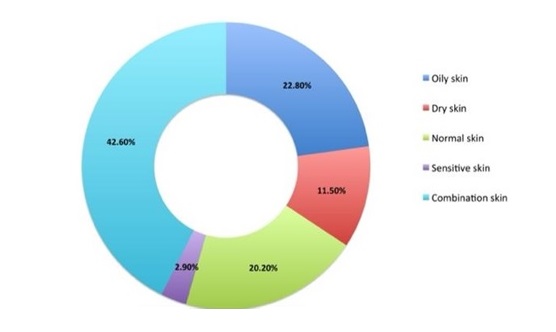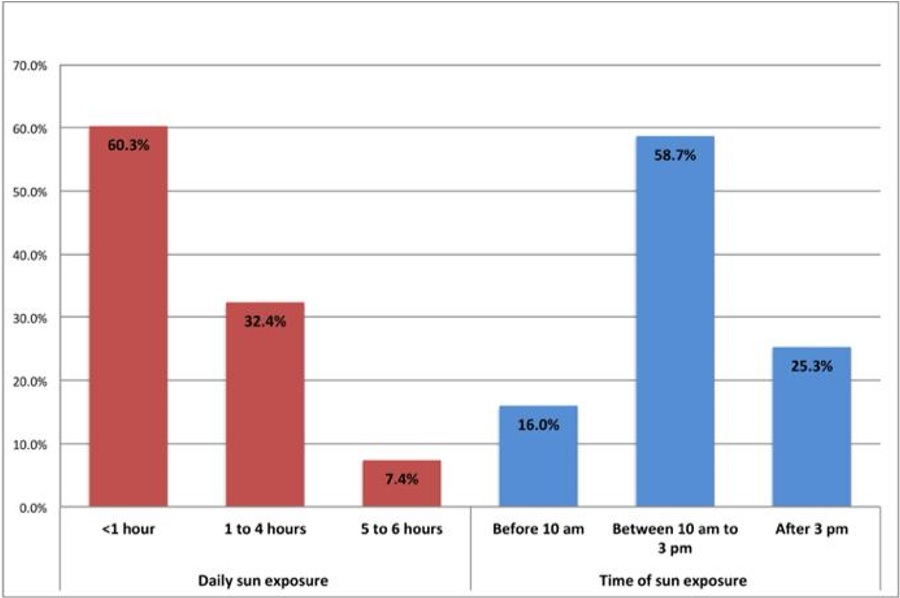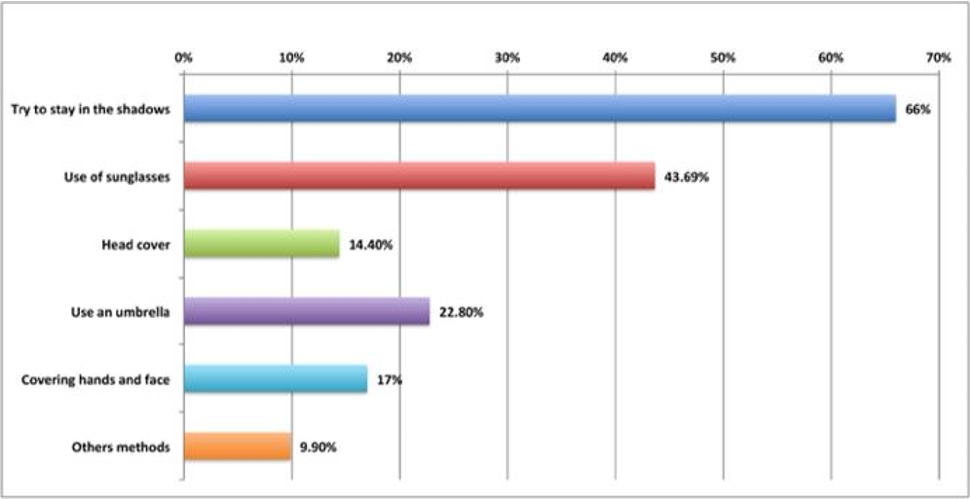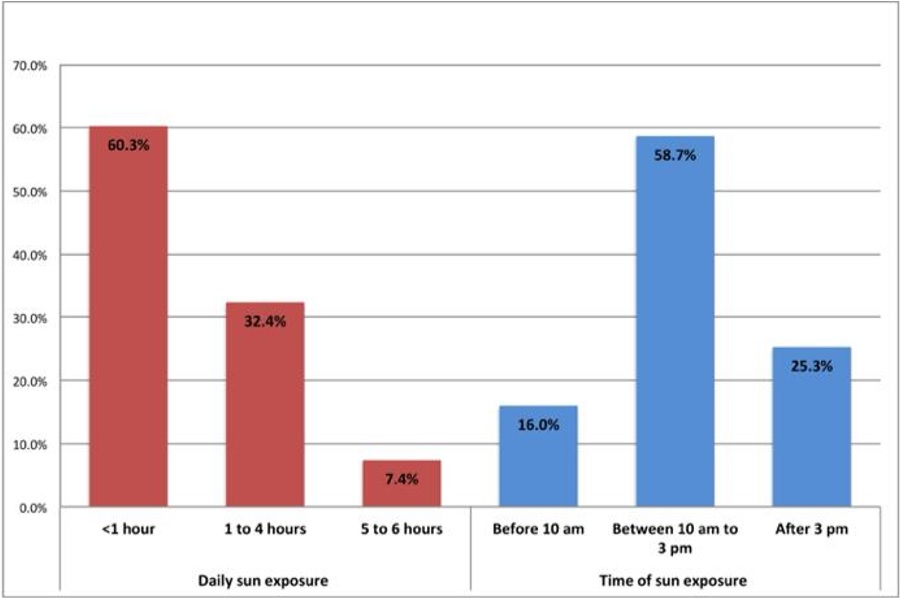Volume 1, Issue 4
July 2021
Knowledge, Attitude, and Practices Toward Sun Exposure and Use of Sun Protection Among Students in Taif University at Saudi Arabia: A Cross-Sectional Study
Daifullah Al Aboud, Huda AlEssa, Sahar Alabbasi, Nada Almalki, Hanan Almalki, Shatha AlJuaid, Sarah Al Otaibi
DOI: http://dx.doi.org/10.52533/JOHS.2021.1404
Keywords: sun exposure, sun protection, awareness, knowledge, practice, taif, saudi arabia
Introduction:
Sunlight exposure has both beneficial and detrimental effects, as it is the primary source of vitamin D and is also a major cause of skin damage, burning, and cancer. Ultraviolet protection is an important main preventive technique against skin cancer and sun damage, which is the most common skin disease worldwide, and the ninth most frequent cancer in Saudi Arabia. The main aim of this study is to determine the knowledge, attitude and practices toward sun exposure and use of sun protection among university students in Taif city of Saudi Arabia.
Methods:
This is a cross-sectional electronic-based survey study that was conducted between the 1 September 2020 and 30 August 2021. The targeted population involved all Taif university students, with a total number of 329 students included in the study. The survey data included items related to demographic information, knowledge, attitude, and practice toward sun exposure and use of sun protection measurements.
Results:
The daily duration of sun exposure among the participants was reported by 60.3% (n=188) as only for less than one hour, 32.4% (n=101) were exposed for one to four hours, and only 7.4% (n=23) were exposed between 5-6 hours. The prevalence of sunscreen usage among the study participants was found to be 71.1% (n=222), and the frequency of sunscreen usage showed 21.6% (n=48) used it 'always', 33.3% (n=74) used it ‘sometimes’, and 45% (n=100) used it ‘rarely’, when they go out in the sun.
Conclusion:
A large percentage of students in Taif university are exposed to ultraviolet rays as their university days peak during sun hours. Only a small percentage were found to always use sun protection methods. More awareness campaigns on campus and social media about the importance of using sun protection measures and the proper way of using sunscreen are required.
Introduction:
Sunlight exposure has both helpful and harmful impacts, as it is the main way to obtain vitamin D and it also plays a significant role in skin damage, sunburns and malignancy (1, 2). Excessive ultraviolet (UV) radiation can harm skin cells and influence the skin's normal development (3). Furthermore, UV radiation is considered the main risk factor for many other skin conditions (4). Consequently, all of these harmful effects are avoidable by using preventive strategies such as sunscreen, sunglasses and protective clothing (3). Sunscreen is the most recommended strategy against UV radiation, acting by preventing the sun’s radiation from reaching the skin (5). It is a chemical substance formulated to protect skin from harmful effects of sunlight exposure and reduce the risk of skin cancer by blocking the harmful UV radiation from reaching the skin (1).
Skin cancer is the world's most common form of cancer, and Saudi Arabia's ninth most common malignancy (2). The incidence of skin cancer has risen significantly worldwide in recent decades and reached epidemic proportions. In the fair-skinned population, the incidence of skin cancer has doubled since 1950, but the rate has remained relatively small for the geographical areas with dark skins such as Africa (6). Sunscreen protective creams and tools are considered the first line of protection against the adverse effects of radiation, according to scientists (2). Research on sun exposure and sun protection methods including sunscreen use have been performed worldwide (5). However, studies exploring the use of sunscreen in Saudi Arabia are scarce (7). These studies suggest that sunscreen is used by 8-35% of the population. A large portion of those using sunscreen were university students (1).
A previous cross-sectional research study in 2019 among Saudi non-medical female students showed that there was a good level of awareness among female university students about the consequences of unprotected sun exposure. On the other hand, there was minimal sun protection behavior and a low use of sunscreen products (2). Another cross-sectional study in Australia, at the Australian National University, aimed to assess the sun?protection practices among undergraduates’ students. The study involved 3,341 randomly selected individuals from both genders. The results showed that only a third of the sample used sun protection, suggesting an increased risk of sun damage (8).
Additionally, a cross-sectional survey was conducted on both males and females in a national survey in Saudi Arabia. The study specified that there were a low level of public awareness among the Saudi people regarding both sun exposure dangers and sun protection measures (3). In 2016, a study indicated that the male and younger age groups had higher exposure to the sun than the female groups, so it leads them to be more vulnerable to skin hyperpigmentation. In contrast, women covering their hair and face were less vulnerable (2). In 2020, a previous study involving 1,011 students found that in 59% of students, sunscreen with a sun protection factor (SPF) > 30 was used. On both sunny and cloudy days, only 35% of students applied sunscreen, while more than 90% of students applied insufficient sunscreen (1).
Because the Kingdom of Saudi Arabia is located in the Arabian Peninsula, which has a very hot summer climate that is mostly sunny throughout the year with a high UV index especially in the months from April to August, it is important to consider and increase awareness of protective measures.
Methodology:
This is a cross-sectional study design that was done using a self-administrated survey on students from Taif university. Our study was conducted at Taif city in Saudi Arabia between the 1st of September 2020 until the 30th of August 2021. The study includes Taif university students with a sample size of 329 and the information that was obtained from the participants by the questionnaires included students from both genders in all ages, while we excluded anyone outside the university. A soft-copy questionnaire was used to collect data and was distributed using the Whatsapp application among student groups. The first part of the survey collected demographic data while the second part was about evaluation the students' knowledge, attitude and practice toward sun exposure and use of sun protection measures. All participants were informed of the demands of the study, and consent was obtained from all enrolled students in the surveys. Skin types were categorized according to Mercurio et al. study to five categories (9).
Data was entered on the computer using Microsoft Office Excel for windows. Afterwards, the data was transfer to the Statistical Package of Social Science Software (SPSS) program, version 21 (IBM SPSS Statistics for Windows, Version 21.0. Armonk, NY: IBM Corp.) to be statistically analyzed. Quantitative data was expressed as mean and standard deviation (SD) while qualitative data was expressed as frequencies and percentages. Suitable statistical tests were applied, and the significant level was set at or less than 0.05.
Results:
The study aimed to assess the perceptions and practices related to sun exposure among Taif University students. 29.5% of the study participants were medical students, while the majority were from outside the medical field (70.5%) (Table 1). The assessment of participants’ skin types showed that 71 (22.8%) had oily skin, 36 (11.5%) had dry skin, 9 (2.9%) had sensitive skin and 133 (42.6%) had a combination type (Figure 1).

Figure 1. Skin type as reported by the participants
|
Table 1: Sociodemographic details of the participants |
|||
|
n |
% |
||
|
College |
Medical |
92 |
29.5 |
|
Non-medical |
220 |
70.5 |
|
|
Gender |
Female |
272 |
87.2 |
|
Male |
40 |
12.8 |
|
|
Nationality |
Saudi |
298 |
95.5 |
|
Non-Saudi |
14 |
4.5 |
|
|
Age |
18-20 years |
132 |
42.3 |
|
21-25 years |
168 |
53.8 |
|
|
26-30 years |
9 |
2.9 |
|
|
>30 years |
3 |
1.0 |
|
|
Socioeconomic |
High |
22 |
7.1 |
|
Medium |
263 |
84.3 |
|
|
Low |
27 |
8.7 |
|
n: numbers
When we assessed the daily duration of sun exposure among the participants, it was reported that 188 (60.3%) were exposed for less than one hour, 101 (32.4%) had exposure between one to four hours and only 23 (7.4%) reported an exposure between five to six hours. The time of sun exposure showed that 50 (16%) reported their exposure before 10 am, 183 (58.7%) reported their exposure from 10 am to 3 pm and 79 (25.3%) were exposed after 3 pm (Figure 2).

Figure 2. Frequency and duration of sun exposure as reported
On assessing other methods used other than sunscreen for sun protection, it was found that 43.69% used sunglasses when they got out, 14.2% used headcover, 22.8% used an umbrella, and 17% covered their hands and face (Figure 3). In addition, 57.1% of the participants believed that frequent exposure to sun rays accelerates the appearance of aging signs. About 196 (62.8%) of the participants believed that frequent exposure to sunlight causes skin cancer and 145 (46.5%) believed that skin cancer could cause death. The sources of sun exposure-related information showed that 71.2% from internet and social media, 61% from newspapers, 35.3% from school or college, 24% from family and friends and 7.1% got it from television. Practices related to sun cream usage showed that 28.8% never used any sun cream before. Meanwhile, from those who used it, 46.2% used it to prevent dark spots on the skin and 37.5% used it on their face, hands and neck. In addition, most of the participants who used sun scream (68.1%) applied it only once during the day (Table 2).
|
Table 2: Practices related to sun cream usage |
|||
|
n |
% |
||
|
Use of Sun cream (n=312) |
Always |
48 |
15.4 |
|
Sometimes |
74 |
23.7 |
|
|
Rarely |
100 |
32.1 |
|
|
Never |
90 |
28.8 |
|
|
Reasons for using sun cream (n=222) |
Sunburn prevention |
136 |
43.6 |
|
Dark skin spots prevention |
144 |
46.2 |
|
|
Skin cancer prevention |
58 |
18.6 |
|
|
Maintaining light skin color |
109 |
34.9 |
|
|
Skin wrinkling prevention |
63 |
20.2 |
|
|
Doctor recommendation |
20 |
6.4 |
|
|
Family or friend’s recommendation |
34 |
10.9 |
|
|
Social media influence |
12 |
3.8 |
|
|
Others |
2 |
0.6 |
|
|
Reasons for not using sun cream (n=90) |
Time consuming |
46 |
14.7 |
|
Inconvenience |
37 |
11.9 |
|
|
Lack of efficacy |
45 |
14.4 |
|
|
Cost |
42 |
13.5 |
|
|
Not heard about it |
2 |
1.0 |
|
|
Allergy |
8 |
2.6 |
|
|
Others |
18 |
5.8 |
|
|
Sun-cream Applied areas (n=222) |
Face, hands & neck |
83 |
37.5 |
|
Hands and face |
60 |
27.2 |
|
|
All exposed parts of the body |
82 |
37.1 |
|
|
Frequency of application (n=222) |
Once |
151 |
68.1 |
|
Every two hours |
19 |
8.6 |
|
|
Whenever I felt my skin needs sun protection |
52 |
23.3 |
|

The prevalence of sunscreen usage among the study participants was found to be 222 (71.1%). Regarding the frequency of sunscreen usage, 48 (21.6%) always used it, 74 (33.3%) used it sometimes, and 100 (45%) used it rarely when they go out in the sun. When we assessed the relationship of sunscreen usage with sociodemographic characteristics, it was found that the participants' nationality, gender, and age showed a statistically significant association. Participants who were Saudi citizens used sunscreen 'always' (16.1%) compared to non-Saudis (0%) that showed a statistically significant association (p=0.016). Meanwhile, on exploring the relationship of frequency of sunscreen usage and gender, it was found that females were more likely to always use sunscreen (16.9%) compared to males (5%), which showed a statistically significant association (p<0.001). The age comparison showed that participants younger than 20 years old always used sunscreen more often than other age groups and this was also statistically significant (p=0.002). There were no significant differences in frequency of sunscreen usage observed between skin type (p=0.323) and socioeconomic status (p=0.300) (Table 3).
|
Table 3: Relationship of sun cream usage with sociodemographic details and skin type |
||||||||
|
Frequency of sun cream usage |
Total |
p value |
||||||
|
Always |
Sometimes |
Rarely |
Never |
|||||
|
College |
Medical |
16 |
17 |
25 |
34 |
92 |
0.122 |
|
|
17.4% |
18.5% |
27.2% |
37.0% |
100.0% |
||||
|
Non-medical |
32 |
57 |
75 |
56 |
220 |
|||
|
14.5% |
25.9% |
34.1% |
25.5% |
100.0% |
||||
|
Nationality |
Saudi |
48 |
66 |
96 |
88 |
298 |
0.016* |
|
|
16.1% |
22.1% |
32.2% |
29.5% |
100.0% |
||||
|
Non-Saudi |
0 |
8 |
4 |
2 |
14 |
|||
|
0.0% |
57.1% |
28.6% |
14.3% |
100.0% |
||||
|
Gender |
Female |
46 |
68 |
92 |
66 |
272 |
<0.001* |
|
|
16.9% |
25.0% |
33.8% |
24.3% |
100.0% |
||||
|
Male |
2 |
6 |
8 |
24 |
40 |
|||
|
5.0% |
15.0% |
20.0% |
60.0% |
100.0% |
||||
|
Age |
<20 years |
28 |
33 |
44 |
27 |
132 |
0.002* |
|
|
21.2% |
25.0% |
33.3% |
20.5% |
100.0% |
||||
|
21-25 years |
17 |
38 |
54 |
59 |
168 |
|||
|
10.1% |
22.6% |
32.1% |
35.1% |
100.0% |
||||
|
26-30 years |
3 |
0 |
2 |
4 |
9 |
|||
|
33.3% |
0.0% |
22.2% |
44.4% |
100.0% |
||||
|
>30 years |
0 |
3 |
0 |
0 |
3 |
|||
|
0.0% |
100.0% |
0.0% |
0.0% |
100.0% |
||||
|
Socioeconomic status |
High |
3 |
6 |
7 |
6 |
22 |
0.300 |
|
|
13.6% |
27.3% |
31.8% |
27.3% |
100.0% |
||||
|
Medium |
40 |
63 |
89 |
71 |
263 |
|||
|
15.2% |
24.0% |
33.8% |
27.0% |
100.0% |
||||
|
Low |
5 |
5 |
4 |
13 |
27 |
|||
|
18.5% |
18.5% |
14.8% |
48.1% |
100.0% |
||||
|
Type of skin |
Normal skin |
10 |
17 |
14 |
22 |
63 |
0.323 |
|
|
15.9% |
27.0% |
22.2% |
34.9% |
100.0% |
||||
|
Oily skin |
11 |
12 |
32 |
16 |
71 |
|||
|
15.5% |
16.9% |
45.1% |
22.5% |
100.0% |
||||
|
Dry skin |
5 |
9 |
9 |
13 |
36 |
|||
|
13.9% |
25.0% |
25.0% |
36.1% |
100.0% |
||||
|
Sensitive skin |
1 |
4 |
1 |
3 |
9 |
|||
|
11.1% |
44.4% |
11.1% |
33.3% |
100.0% |
||||
|
Combination skin |
21 |
32 |
44 |
36 |
133 |
|||
|
15.8% |
24.1% |
33.1% |
27.1% |
100.0% |
||||
* Statistically significant
Discussion:
The present study is a cross-sectional survey that was carried out on a sample of 312 Students in Taif University, Kingdom of Saudi Arabia, to determine the knowledge, attitude, and practices toward sun exposure and use of sun protection. Findings from this study indicate that almost one third of the sample (32.1%) rarely used sunscreen, which is considered a large proportion. Moreover, the majority of those students were non-medical (70.5%) and from the age group of 21-25 years old. Furthermore, we found that 71.1% of participants use sunscreen methods which can be translated into a good practice. In comparison, a similar study performed in a Saudi university reported that roughly 51% of the population used sunscreen (1). The prevalence of sunscreen use in our study was also higher than that same study. In our study, 21.6% always used sunscreen protection, 33.3% used it sometimes, and 45% used it rarely. These results differ from a similar study that was done at Prince Sattam Bin Abdulaziz University which showed that 24.1% used it only when they went to the beach, and (10.5%) used it sometimes throughout the year (7). This finding may be related to the nature of the weather in our region as it is summer-like most of the year, which may encourage students to use sunscreen more frequently.
A German cross-sectional study showed that 79.4% of the participants always used sunscreen, compared to our population of 21% (10). Results of our study revealed no significant difference (p=0.122) between the rate of sunscreen use (always or sometimes) among medical students (35.9%) compared to non-medical students (40.4%). On the other hand, participants’ gender was found to significantly affect the rate of sunscreen use where the percentage of female participants always or sometimes using sunscreen was 41.9% and was statistically significant (p<0.001) when compared to male participants with a reported frequency of 20%. This is consistent with the results of a previous study conducted among Saudi students which revealed that 26% of male students and 77% of female students used sunscreen (1). Another study conducted among Pakistani medical students showed that 26.1% of the males and 73.9% of the females reported using sunscreen (11). In addition, a study in the United States showed that 18.1% of men and 42.6% of women regularly used sunscreen on their face (12). Similarly consistent results were reported in a Jordanian?based survey where 73.1% of the females and 25.3% of the males reported using sunscreen (13).
In our research, socioeconomic status had no substantial impact on the rate of sunscreen usage in comparison to the proportion of participants who reported the use of sunscreen as often or sometimes. Meanwhile, the high socioeconomic class (40.9%) did not vary significantly from those in the medium (39.2%) or low (37%) socioeconomic groups. Similarly, a Saudi study by Al-Jasser et al. found that 58% of students with high socioeconomic status, 43% of students with medium socioeconomic status and 40% of students with low socioeconomic status reported using sunscreen (1). Comparing our study to another Pakistani study, it was found that 10.8% of participants with high socioeconomic status, 88.2% of participants with medium socioeconomic status and 1% of participants with low socioeconomic status reported using sunscreen (11).
On evaluating methods used other than sunscreen for protecting the skin, we found that 14.2% used head cover, and 17% cover both hands and face. In 2016, a study by Al-Ghamdi et al. in Saudi Arabia reported that 90% of respondents wore head cover, and 93% of the female respondents reported using a face cover. This finding may be due to the fact that the Saudi community has many customs related to clothes (3). However, a published study suggested that 73% of participants reported that the covering of the face (hijab) wasn't adequate to replace sunscreen products (2). The present study showed the most common reasons for using sunscreen was prevention of sunburn, dark skin spots, skin cancer and maintaining light skin color. These results are in line with Al-Jasser’s findings, which showed sunburn and dark skin spot prevention were the main reasons for using sunscreen (1).
In our study, 57.1% of the participants believed that frequent exposure to sun rays accelerates the appearance of aging signs, whereas approximately 62.8% believed that frequent exposure causes skin cancer and 46.5% believed that skin cancer could cause death. This was similar to Al-Ghamdi et al.’s study findings (3). A possible explanation for these results may be that university students are highly exposed to sunlight which leads them to know more about the side effects of frequent exposure.
Limitations in our study include not being representative of the whole population of Taif. In addition, most of the participants were female, which can significantly affect the comparative results of the male respondents. No logistic regression was performed due to the small sample size. Further studies are needed in Taif city to explore the knowledge, awareness and practice of sunscreen protection methods among the community.
Conclusion:
A large percentage of students in Taif university are exposed to ultraviolet rays and only a small percentage of them use sunscreen frequently. As a result, more awareness campaigns about the importance of using sunscreen for skin safety are needed on both the main campus and on social media, as this was found to be the most popular source of information for students in Taif university.
Acknowledgement
We would like to thank our supervisor Dr Eman Mohy for her guidance and support throughout this project. Also, we would like to thank all participants who took part in our study and took the time to answer our questionnaire.
Declaration
Statement:
The authors declare no conflict of interest.
Funding:
None
Ethical Consideration:
The study was approved by the Institutional Review Board (IRB) of Taif University with ethical approval number HAO-02-T-105. All participants signed an electronic consent to participate in the study. All methods were performed in accordance with the relevant guidelines and regulations Declaration of Helsinki.
Data Availability:
All data is available within the article itself. The survey used in this study is in the supplementary materials. Any further data or details will be provided by contacting the corresponding author.
